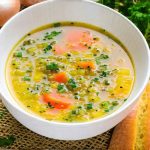The quest for satisfying meals that don’t leave you feeling sluggish, bloated, or weighed down is one many people share. We often associate fullness with heavy, rich foods – large portions of pasta, creamy sauces, fried dishes. But true nourishment and lasting energy come from a different approach: crafting light, yet deeply fulfilling, meals that prioritize both taste and digestive comfort. It’s about working with your body, not against it, understanding how food impacts our energy levels and overall well-being. This isn’t about deprivation or restrictive dieting; it’s about mindful choices and a shift in perspective regarding what constitutes a satisfying meal.
Many factors contribute to feelings of heaviness after eating – portion sizes are obvious, but the combination of foods, cooking methods, and even how quickly we eat play significant roles. Often, these effects aren’t due to inherently “bad” foods, but rather an imbalance or overabundance of certain elements. For example, a large serving of healthy avocado is still a large serving, and can be difficult for some to digest if not balanced with lighter components. Understanding the principles behind light eating allows you to enjoy a wide variety of foods without sacrificing comfort. We’ll explore strategies that focus on building meals that are both enjoyable and easily digestible, promoting sustained energy throughout your day. It’s important to understand daily habits that might be contributing factors too.
Building Blocks of Light & Satisfying Meals
The foundation of light meal crafting lies in understanding food composition and how different elements impact digestion. Protein, fats, and carbohydrates all play crucial roles, but the type and quantity matter immensely. For instance, lean proteins are easier to digest than fatty cuts of meat, complex carbohydrates provide sustained energy compared to simple sugars, and healthy fats – in moderation – contribute to satiety without heaviness. Prioritizing whole, unprocessed foods is paramount. These foods naturally contain fiber, vitamins, and minerals that support digestion and overall health. Think vibrant vegetables, fruits, lean proteins like fish or poultry, and complex carbohydrates such as quinoa or sweet potatoes. If you are planning a workout, consider pre-workout meals that won’t leave you feeling full.
Furthermore, the way we combine these elements matters. A meal consisting solely of dense, heavy foods will inevitably feel…heavy! The key is to balance textures and densities. Pairing a lighter protein source with plenty of fiber-rich vegetables creates a more balanced and digestible experience. For example, grilled chicken breast with steamed broccoli and quinoa provides protein, essential nutrients, and sustained energy without the feeling of being overly full. Consider incorporating fermented foods like yogurt or kimchi – these introduce beneficial bacteria that aid in digestion. Managing acid buildup is also vital, especially after larger meals.
Finally, don’t underestimate the power of mindful eating practices. Slowing down, chewing thoroughly, and paying attention to your body’s hunger cues can drastically improve digestion and prevent overeating. It’s about savoring each bite and recognizing when you’re comfortably full, rather than stuffed. This requires a conscious effort, but the benefits – increased energy, improved digestion, and a healthier relationship with food – are well worth it. Understanding common dietary mistakes can help you avoid these pitfalls.
Optimizing Protein Sources
Protein is essential for satiety and muscle maintenance, but some sources are far more digestible than others. Red meat, while nutritious, can be heavier on the system due to its higher fat content and slower digestion time. Leaner protein options like fish (salmon, tuna, cod), poultry (chicken breast, turkey), beans, lentils, tofu, and tempeh are excellent choices. These provide ample protein without causing digestive distress. When choosing animal proteins, opt for grass-fed or organic whenever possible to minimize exposure to hormones and antibiotics.
Preparation methods also play a role. Grilling, baking, steaming, or poaching are preferable to frying, as they avoid adding unnecessary fats. Marinating protein in acidic ingredients like lemon juice or vinegar can tenderize the meat and aid digestion. Furthermore, portion control is key – even lean proteins should be consumed in moderate amounts to prevent overconsumption. A good rule of thumb is to aim for a palm-sized serving per meal.
Consider incorporating plant-based protein sources more frequently into your diet. They are naturally rich in fiber and offer additional health benefits. Lentils, for example, are an excellent source of protein, fiber, and iron, making them a satisfying and easily digestible option. Tofu, when prepared correctly (baked or stir-fried with minimal oil), is another versatile plant-based protein that can be incorporated into various dishes.
Harnessing the Power of Fiber
Fiber is often touted as being “good for you,” and rightfully so. It plays a crucial role in digestive health and promotes feelings of fullness, preventing overeating. However, not all fiber is created equal. Soluble fiber dissolves in water, forming a gel-like substance that slows down digestion and helps regulate blood sugar levels. Sources include oats, beans, apples, and carrots. Insoluble fiber, on the other hand, adds bulk to stool and promotes regularity. It’s found in whole grains, vegetables, and fruits with edible skins.
A balanced intake of both soluble and insoluble fiber is ideal. Gradually increasing your fiber intake is essential – sudden increases can lead to bloating and gas. Start by adding small amounts of fiber-rich foods to your diet and gradually increase the quantity over time. Drinking plenty of water is also crucial, as fiber absorbs water, and adequate hydration prevents constipation.
Focus on incorporating a variety of fruits and vegetables into your meals. Berries, leafy greens, broccoli, and Brussels sprouts are all excellent sources of fiber and nutrients. Whole grains like quinoa, brown rice, and oats provide sustained energy and digestive benefits. Remember to choose whole grain options over refined grains whenever possible, as they retain more fiber and nutrients. It’s helpful to track food triggers if you suspect certain foods are causing issues.
Mastering Mindful Eating Techniques
Even the healthiest meal can feel heavy if eaten too quickly or without attention. Mindful eating is about cultivating awareness around your food and your body’s signals. It’s a practice that requires conscious effort but yields significant benefits for digestion and overall well-being. One simple technique is to slow down – put your fork down between bites, chew thoroughly, and savor the flavors. This allows your digestive system to keep up and prevents overeating.
Before you even begin eating, take a moment to appreciate your food. Notice its colors, textures, and aromas. Consider where it came from and the effort that went into preparing it. This mindful appreciation can enhance your enjoyment of the meal and promote gratitude. Pay attention to your hunger cues. Start eating when you’re moderately hungry and stop when you’re comfortably full – not stuffed.
Eliminate distractions while eating, such as television or smartphones. Focus solely on your food and the experience of eating. Listen to your body and pay attention to any signs of fullness or discomfort. If you start to feel overly full, slow down or stop eating altogether. Mindful eating isn’t about restriction; it’s about creating a more conscious and enjoyable relationship with food that supports both physical and mental well-being. It’s about recognizing your body’s needs and responding accordingly, leading to sustained energy and digestive comfort. Be aware of dinner mistakes that can affect digestion as well.


















